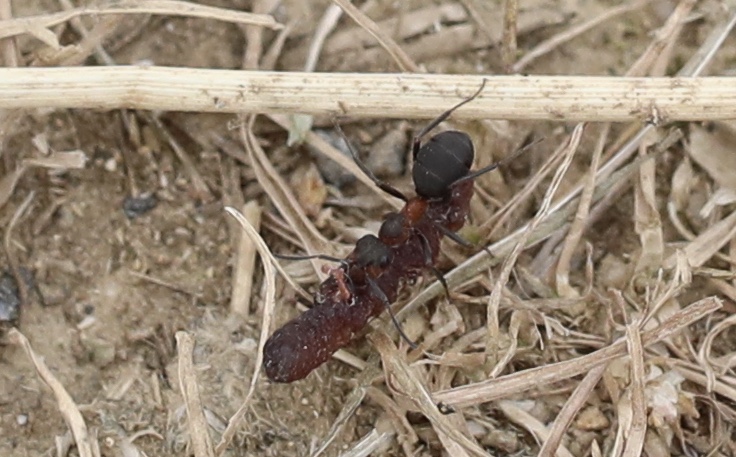
The Black-backed Meadow Ant, Formica pratensis, is decreasing across it range and is now considered extinct in the UK. It’s conservation status is near-threatened. In Guernsey, it is a key species which means if these ants are doing well it’s a sign of a healthy habitat with good biodiversity (lots of plant and animal species).
This species is larger than the black garden ant. The thorax (middle section) is reddish brown with a small black ‘saddle’ and the abdomen is matt black with three shiny black stripes. They are best seen on warm, sunny days in early spring when the nest mounds are swarming with ants probably enjoying the sunshine and working on the thatch of dry grass and small twigs that keep the nest insulated.

Most nests are located along the paths of the south coast cliffs where conditions are warmer and drier than elsewhere in the island. There is a surviving nest on Lihou Headland on the west coast and just a few in field banks in the high parishes (Torteval, St Saviour, St Peter and the Forest).
Some well-established nests can measure over a metre across and they can have a life span of at least twenty years. Each of these nests may have a population of around 60,000 ants – just about one ant for every person who lives on the island. The ants will create foraging runs (using pheromones as a scent) to areas where there are aphids. These can be seen clearly near some nest sights. One was about 30m long. The worker ants are female. They can drag quite large prey items and carrion back to the nest, typically caterpillars and earthworms. If one of the workers dies, others will take the body back to the nest. Nothing is wasted.
The colony can move their nest. Julia Henney, Biodiversity Officer for the States of Guernsey and Vice-President of La Société, witnessed this at a nest near Le Gouffre. The nest was moved about 10 metres to the west and for at least 3 days, worker ants were observed carrying adult ants from the old nest to the new site in their jaws, then returning to the old nest to carry away another ant.

Since the 1990s, the number of nest sites has declined. This is probably due to a number of factors: increased human disturbance, changing habitat and possible changing climate.
Electric strimmers are used to keep paths clear of vegetation over the summer. They are much quicker than using a French hook but the nests can be surprisingly difficult to see and some may have been inadvertently lost in this way. The changing climate means that we have more wet weather which does not suit these ants. The cliffs are not grazed as they used to be so plants like blackthorn grow higher, and other plants like bracken and the invasive sour fig now cover swathes of the cliff and shade out the nests.
Since 2017 I have volunteered to record and monitor the nests along the cliff path. For the past three years, nests that are very close to the path are marked with red flags so the clearance team can see them. This has been a useful strategy, although it would appear that new nests struggle to get established and many simply die out in their first year or so.

In late spring, winged ants (aleates) will emerge from the nest. These are males and females who will mate. The male soon dies and the female will fly a short distance before losing her wings, or she will actively chew them off.

She will then try to find a suitable area where she can burrow into the ground and start laying eggs. She will do this for the rest of her life which could be for fifteen years. It is thought that if a queen dies, she may be replaced and the nest can continue, but the chances are that once the queen is dead, the nest will not survive for long.
Nest Stats
As a purely arbitrary measure, a nest is counted if the measures 25x25cm. The figures that follow are approximate – nests can easily be overlooked one year and re-found the next.
2017 – 63
2018 – 58
2019 – 72
2020 – 77
2021 – count in progress. Watch this space!